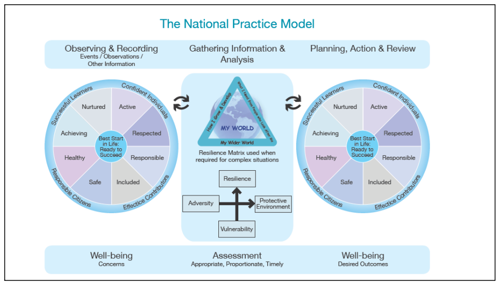The general purpose of a multi agency child protection assessment are –
- Gather, share and analyse such information about a child, family and relevant context as may be necessary for the purpose of determining harm or risk of harm
- To inform planning of action and support necessary to ensure a child’s safety and wellbeing
Effective engagement to reduce risk is more likely within approaches which stress respectful and rights-based communication with children and families, build upon strengths that have been evidenced, address need and risk, and work with the interaction of relationships and factors in the child’s world.
In forming a multi-agency view of risks and strengths and options for supported change, strength-based approaches provide a vehicle for partnership in critical situations.
Assessment evolves with new information and understanding. Any assessment is at a point in time. Immediate safety is a priority. There are likely to be distinctive stages, moving from initial assessment and prevention of significant harm to comprehensive inter-agency assessment of risk and need in context. Professional judgement and reflection on evidence and analysis is necessary at every stage. Even in urgent circumstances there should be a moment to pause and consider safety and best interests within the available options.
Attention should be paid to professional intuition, however this must be located firmly within an agreed and approved framework and approach. Professional curiosity about how children and families are experiencing their situation from the inside out is critical to effective engagement and formation of an understanding of risk and strengths in the child’s world.
Whatever the specific concern, effective multi-agency assessment, planning and support is ecological. This includes analysis of the interaction of relationships between a child, their family and their wider world and includes consideration of the present and historical context of harm. Other factors may be relevant such as culture, use of technology, the physical location of risks, barriers to understanding or accessing services, and the interface between adversities including key variables like housing, health and income.
Effective multi-agency assessment must be developmental, meaning that it should consider a child’s age, stage and transitional needs moving on to another stage, even if the preoccupation of a child protection assessment is prevention of significant harm. A developmental perspective encompasses attention to the impact of a child’s experience of attachment and of trauma, and the relevance of relationships with significant others such as siblings and non-resident parents upon assessment of risk, strengths and need.

